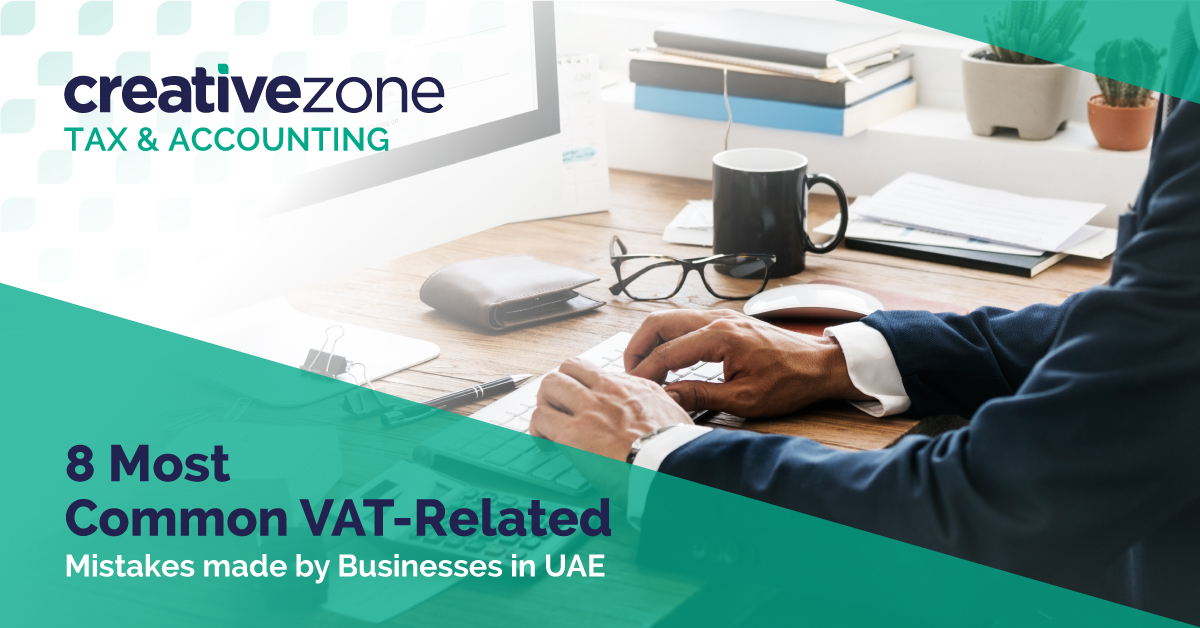VAT was implemented in UAE on January 1, 2018. Since then, businesses are subject to a number of requirements under the VAT Law. Each business enrolled for VAT has an obligation to file VAT returns with the Federal Tax Authority (FTA). However, UAE businesses continue to make VAT-related mistakes and suffer from it.
If we take the example of the United Kingdom, despite the fact that VAT was introduced in the in 1973, research suggests that over half (51%) of small business owners make errors when completing their tax returns, resulting in excess taxes being paid to HMRC.
It is for this reason, however, that you must be extra cautious when filing your VAT return and you should also watch out for some common mistakes in this process. We have attempted to identify some of the most common VAT errors and mistakes while filing VAT returns by using this blog.
8 Most Common VAT-related Mistakes Made By Businesses in UAE
The following errors are commonly made by businesses in filing VAT returns in the United Arab Emirates:
1. Late Filing Of VAT Returns
A VAT return must be filed within certain deadlines in the United Arab Emirates. We have seen this VAT-related mistake on a number of occasions. In order to ensure that the VAT returns are filed on time, the FTA has defined quarterly and monthly deadlines. For businesses to avoid any last-minute rush that may lead to errors in calculations or omissions, it is extremely important to remain on top of these deadlines and complete the tax returns filing process well ahead of time.
2. Failure To Maintain Records
In the UAE, the VAT laws require that businesses maintain records of their transactions for at least 5 years (15 years in the case of real estate) in order to facilitate VAT filing and bookkeeping. This includes all payments, receipts, expenditures, and other documentation that supports VAT filings. Unfortunately, many companies fail to maintain all these accounts, or even if they do, they fail to update and maintain them regularly.
3. Incorrect “Tax Point”
For tax purposes, tax point (or “time of supply”) can be defined as the date on which the transaction occurs. As a consequence, you should ensure that the transactions that fall within the specific tax points are included on the appropriate return during the tax period. The most common mistake occurs when supplies take place at the end of a tax quarter. They are then included in the incorrect return.
4. Mistakes When Calculating Vat
The application of correct VAT rates is the most important component of preparing accurate VAT returns. Business owners make errors when it comes to identifying the appropriate rate of VAT for the goods and services they offer. Due to this, calculations and payments will be more inaccurate, which may result in fines.
5. Issues With Reverse Charge Mechanism
There are usually inaccuracies in transactions involving reverse charge mechanisms. That is because goods and services are imported from abroad. Often, businesses forget to include transactions covered by the reverse charge mechanism in the VAT returns they submit for filing. Nevertheless, these transactions are included in the business’s VAT returns since they have to pass through customs as part of the existing procedure. Thus, businesses should be very careful in reporting transactions of this kind and seek professional assistance.
6. Using Adjustment Columns Incorrectly
In the filing process of VAT returns, businesses don’t understand the actual use of adjustment columns. Adjustment columns can be seen in the VAT return format of the FTA. In reality, adjustment columns are designed for the purpose of adjustment of bad debts and sales of commercial property. In practice, businesses correct errors in previous VAT returns using the adjustment columns. As a result, the FTA might ask more questions and investigate, possibly leading to penalties. For businesses to comply with the VAT returns, they must pay particular attention to each of the columns of information.
7. Bad Debt Relief
FTA offers relief for bad debts as per article 64 of the Federal Decree-Law No. 8 of 2017 on Value Added Tax. Before claiming bad debt, you have to wait six months from the date of supply. Alternatively, if you are paying creditors late, you need to adjust your input VAT accordingly as the tax authority expects you to do so. VAT cannot be claimed on invoices that you have not paid.
8. Absence Of A Tax Professional
In order to leverage the VAT laws, businesses should have tax professionals to handle VAT-related transactions. A competent team of staff is essential for compliance with VAT regulations. It has sometimes happened that the company has hired the wrong group of people who lack the knowledge necessary to understand VAT implications.
Bringing It All Together
In order to reduce the chances of making a mistake, you need to understand where VAT return errors commonly occur and what FTA expects from you.
It is always recommended to have tax experts at your aide. Creative Zone Tax & Accounting is an FTA Approved Tax Agency. We help companies stay on top of their VAT compliance requirements. We have accountants as well as tax consultants who are able to assist you with VAT registration, deregistration, and determining your VAT obligations. You can contact us at vat@cztaxaccounting.ae.

